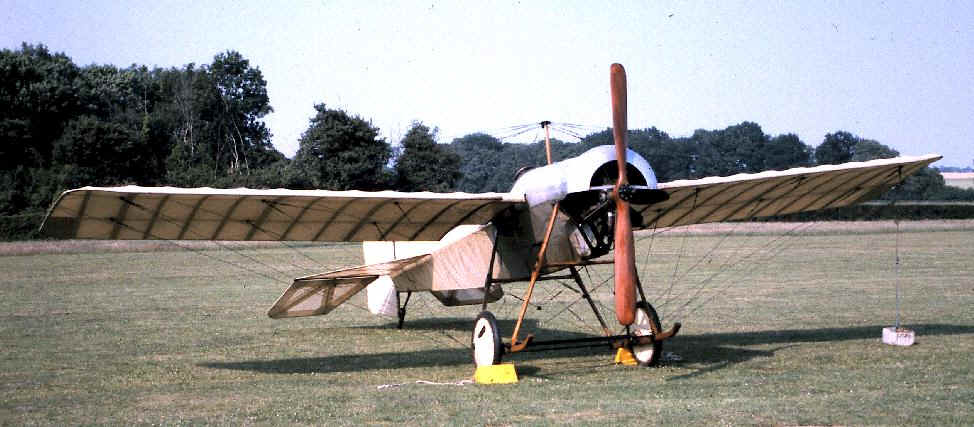
Image du Jours -- Early Aviation
Next Early Aviation Image du Jour
About Early Aviation -- #5 of 7.

Blackburn Monoplane (K. Cashion)
MODERN AIRCRAFT
The last aircraft is one of my favorites -- the 1912 Blackburn Monoplane. The Blackburn is the oldest flying British aircraft in the world.
When we see images of early aircraft, too many of us think, ‘Those guys must have been crazy to go up in one of those string bags.’ Yet, they not only went up in them, they did all sorts of maneuvers and engaged in combat.Again, our context (time and place) gets in the way of our understanding. Those guys thought, ‘Man, look at that beauty! Now there is a real aeroplane! We get to sit down in the fuselage in a wicker seat instead of mostly on the fuselage up in the wind. What a magnificent, modern plane! When can I fly it?’
In the three, short years that lapsed between the Bleriot and the Blackburn, considerable improvements had been made in aviation. The Blackburn was using an engine, the Gnome rotary, which would serve well-into the period after the friendly, waving sportsmen-aeronautists flying over pristine countryside would have become calculating, professional killers in the smoky skies over a mud- and blood-splattered Western Europe.
But before aerial warfare could sully the name of "aeronautist," this particular Blackburn was flying at Hendon along with the Bleriot and Deperdussin. This Blackburn was not part of the flying school, however, it was under private ownership. (Don't you know the owner of this aircraft was the envy of all the students struggling with 'general flight without incident'?)
In 1914, the Blackburn was moved to a barn in Northampshire where it lay until just before WWII when Richard Shuttleworth purchased it.
The rebuilding was interrupted by WWII and it was 1949 before it was finally flight-ready. By then Richard was dead, but his legacy would continue through the Shuttleworth Trust.
For many years at Old Warden Aerodrome, the Blackburn, too, made just short hops, but in 1973, it was overhauled, re-covered, and the Gnome engine rebuilt. Since then, it routinely makes circuits of the aerodrome on good flying evenings.
The Blackburn, built in Yorkshire, had general wing-warping but it had a major horizontal fuselage truss from fire wall to empennage and below this was a triangular cross-section for rigidity and lightness. From nose to immediately aft of the pilot's seat, the top fuselage was skinned with aluminum. The pilot had become more of a passenger, with creature-comforts rather than just sticking him up in the air-stream on top of the fuselage.
The wing span was near 36' and it had a wing-loading of 3.5 lb./sq.ft. It weighed 550 lbs. empty, 800 lbs. max, and it could fly up to 2.5 hours at 60 mph – reliably!
It was powered by the 50 hp, 7-cylinder, Gnome rotary engine. The engine had one valve/push-rod per cylinder, and I hope you know it had the prop bolted to the crankcase with the hollow crankshaft mounted to the aircraft.
This seems backwards but it was a superb design for the time because the finned cylinder heads would be spinning and guaranteeing the engine would get adequate cooling even at low rpms. It developed a lot of torque with the spinning mass and it ran smoother with a larger prop. This gave a larger thrust-disc which was needed for these generally high-drag air-frames.
Before starting, each valve was pushed open with a thumb and the spout of an oil-can filled with gasoline would be inserted into the cylinder through the open valve and two squirts of gas were given to each cylinder. The valve was easy to push open because in operation, the spinning of the engine helped close it, making a strong valve spring unnecessary. This engine configuration would reduce valve wear. It would start with the first throw almost every time if primed in this manner. The engine was easy to start with the mass of the thrown prop spinning the crankcase.
The crankshaft was hollow with a rudimentary carburetor at the end. Sometimes this was well-inside the aircraft. The carburetor had a guillotine choke arrangement that basically gave the carburetor a two-speed setting. One was full speed and the other was just enough to overcome most of the drag...but in that position, you were coming down without fear of stalling in neutral trim. There was an ignition kill switch for modulating the power. The distance from one end of the crankshaft portion to the prop hub could be four-to-five feet.
On some pushers of the era, the arrangement was reversed with the carburetor to the front, the hollow crankshaft secured to the air-frame, then the spinning prop with the entire engine crankcase was the last thing toward the tail -- and this was all "just hanging out there."
You can see one of these engines in operation in most early aviation clips because there is a guy trying to use one with a helicopter arrangement. As it is falling over and the "pilot" is making his escape (if you can ignore the "pilot's" dangerous situation), you can easily see the rotating engine as it goes from horizontal to near vertical as the lifting contraption is hitting the ground...all around the scurrying pilot.
Ken Cashion
Next Early Aviation Image du Jour
Return to Story Index